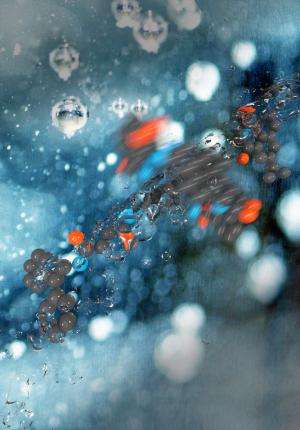Water found to be an ideal lubricant for nanomachines

Researchers from the University of Amsterdam have discovered that machines just one molecule in size move far quicker if you add a 'lubricant' to their surroundings. To their surprise, water proved to be the best lubricant by far. The research will be published on 1 September 2013 in Nature Chemistry.
FOM PhD researcher Matthijs Panman and his colleagues determined the velocity of two nanomachines: minuscule machines just one single molecule in size. They examined a molecular wheel and a molecular motor driven by light. Both machines are made up of just a few dozen atoms and are about one thousandth millionth of a metre in size.
Lubricated motion
The researchers used advanced physics techniques (nuclear spin resonance and ultrafast lasers) to examine the molecular machines. During the research the machines were dissolved in an organic solvent (acetonitrile). The researchers discovered that if a small quantity of water was added to the solvent, the molecular machines moved much faster. Three percent water proved to be enough 'lubricant' to make the movement more than twice as quick.
The researchers added other substances as well but the less similar to water the substance added was, the less good its lubricating effect. Butanol, which in terms of properties is in between water and lubricating oil actually made the movement slower.
Broken bonds
It is not yet entirely clear why water is such a good lubricant for the nanomachines investigated. The lubricating effect is probably associated with the hydrogen bonds (weak bonds) between the groups of atoms that form the two parts of these machines that move with respect to each other.
These hydrogen bonds need to temporarily break open to allow the machine to move. That does not happen easily: normally the two disengaged parts of a broken hydrogen bond quickly 'grasp' each other again, as a result of which the machine does not easily start moving. If water is present, however, the two halves of the bond can form new hydrogen bonds with the water molecules instead of with each other. As a result of this the hydrogen bonds between the moving parts of the machine remain broken for longer – the internal friction of the molecular machine is reduced and the speed increases.
Water molecules have a small size, high motility and easily form hydrogen bonds. Therefore they are probably the ideal candidate for speeding up the machine.
Chance discovery
The experiments began when the researchers noticed that the molecular motors moved with slightly different speeds, dependent on the bottle of solvent used in the experiment. Soon, that turned out to be the case due to traces of water in the solvent. If you open a bottle of solvent several times then a small quantity of water from the air gradually dissolves in it. Some bottles contained slightly more water than others and this gave rise to the difference in speed. By adding more water the researchers managed to enhance the effect.
The discovery is important for the design and optimisation of new nanomachines. The potential applications of such machines range from molecular computers to surfaces with switchable properties. In addition, hydrogen bonds also occur in natural, biological molecular machines where water probably has a lubricating effect as well.
Journal information: Nature Chemistry

















